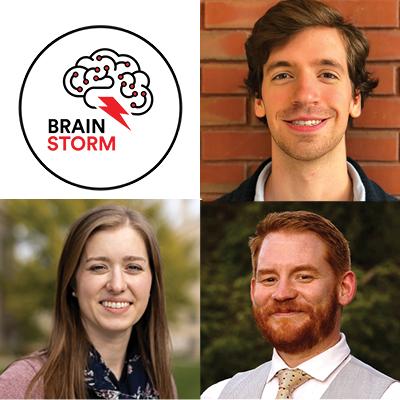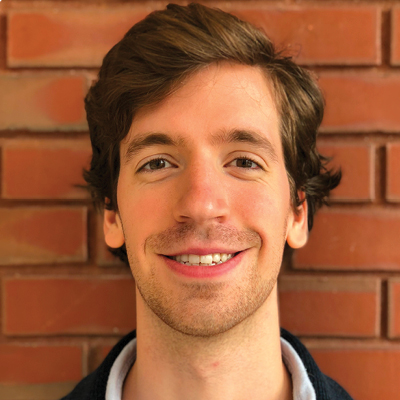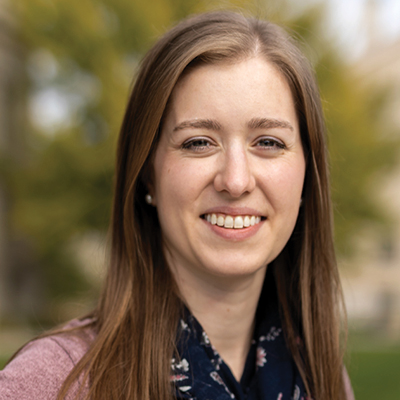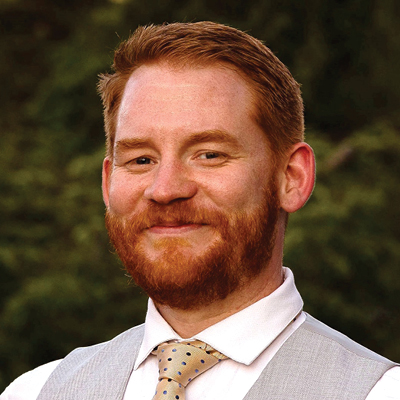Ryan Thorpe, Darcy Diesburg and Chad Williams named winner/runners-up of the 2022 Brainstorm Challenge

Depression is an epidemic in the United States. A mood disorder that causes a persistent feeling of sadness and loss of interest, some 21.0 million adults in the United States, or 8.4% of the population, had at least one major depressive episode in 2020.
As the Mayo Clinic notes, depression is “more than just a bout of the blues… and you can't simply snap out of it. It affects how you feel, think and behave and can lead to a variety of emotional and physical problems.” Those suffering from depression often have trouble getting out of bed, going to work and school, and doing everyday activities, often beset with feelings that life isn't worth living.
For some, talk therapy, medication, and other interventions help ameliorate some of the anguish. For others, their symptoms are doggedly unresponsive to traditional treatments and they find themselves seeking out more assistive care in the hopes of finding some degree of relief. One such treatment is transcranial magnetic stimulation (TMS), a noninvasive procedure using magnetic fields to stimulate nerve cells in the brain that has been shown to help to improve symptoms of depression.
Now consistently covered by insurance for treating depression, TMS has been shown to be a safe and simple procedure with few side effects. However, it's a substantial time and financial commitment for the patient with a regimen consisting of daily treatments for four to six weeks. However, TMS is effective for only 40 - 50% of people with depression who have tried and failed to receive benefit from medication.
Unlike with bone marrow donation where it can be determined well in advance whether a prospective donor is a good match for the recipient, no precursor test exists that — with high confidence — can predict whether TMS will help a depressed patient, thereby avoiding weeks of ineffective and costly treatment.
Into this gulf has stepped the 2022 BRAINSTORM Challenge.
THE BRAINSTORM CHALLENGE
Co-directed by Carney professors Michael Frank and Frederike Petzschner, the BRAINSTORM program “aspires to have a lasting impact on the field of mental health by leveraging ideas and methods from computational brain science.” Each year, the program creates a challenge that invites participants to build and use functional tools to address real-world problems.
This year, participants were provided with electrical brain activity and clinical scores of 172 clinically depressed patients both pre and post treatment with TMS from Linda Carpenter’s Lab at the Butler Hospital. The investigators’ main challenge was to predict, based on electroencephalogram data from the first treatment session, if a patient would respond to TMS treatment. In practice, these predictions would be able to determine which patients would be the best candidates for and most responsive to TMS treatment for depression.
A secondary challenge was to predict improvement in depression based on the entire EEG dataset (including the first and last treatment sessions). Participants were provided with the clinical outcomes (depression scores, etc.) for 100 of these patients for training and cross validating their models. Prizes were awarded to those investigators who scored best on the “private leaderboard” — identified by the accuracy of their predictions about clinical outcomes in the remaining 72 patients, for which they only had access to patients’ EEG and initial clinical scores but not their final scores after treatment.
Working with Brown data analysis experts, participants took part in a one-week workshop before the challenge began. Investigators learned tools they could use to analyze the data including how to employ existing patient biomarkers for depression.
A panel of Carney judges reviewed the submissions and the best predictions and most interesting analysis awarded by prize money of $3000.
THIS YEAR'S WINNERS
Carney spoke with the winner of the 2022 challenge and the two runners-up to learn how they attacked this problem. Learn more about the BRAINSTORM program, their innovators and research here.
Ryan Thorpe is the 2022 Brainstorm Challenge winner. Ryan is a fourth year Ph.D. student in the neuroscience program and works in the labs of Stephanie Jones and Chris Moore.

When you're trying to figure out what's wrong with your car, you don't just sit there and just turn on the engine and listen. You're going to start the car, push on the accelerator, turn the wheel. You want to observe, hear and feel the change points because that's when the clunking starts and whatever's wrong becomes most visible or noticeable.
The same thing with the brain. If you want to observe a robust signal indicative of something going wrong, analysis techniques shouldn’t assume that it's just doing the same thing over regularized periods of time. We need to look for moments when it's shifting, and that's when we notice the “clunking engine” that indicates something is amiss.
For the challenge, I wanted to identify shifts in brain activity following neural transition points. There are several putative markers for neural transitions and, from this field, I chose to use beta events which are high amplitude, transient brain signals oscillating at speeds of 15 to 29 cycles per second (hertz). I focused upon the resting state EEG data for each subject before treatment and then after treatment. I was looking at both of those time series data to see if I could develop a classifier that would take that information and, based off one session, predict if they would respond to TMS.
We know that for someone who's experiencing major depressive disorder, it’s thought that effective TMS treatment is modulating or perhaps shifting brain dynamics that can be measured through beta events and their subsequent activity. My goal was to identify these high amplitude transient beta events and use those as the mark that the brain is sending a signal that it's about to shift gears. I looked at a window of time after each beta event and tried to piece together how all the electrodes spatially synchronized or desynchronized in a specific frequency band over time. By observing the data gleaned from electrodes in a higher frequency brain wave band — the Gamma band — shift after a beta event, I was able to set up the classifier that provided predictions for the validations.
As a student, you’re thrown in the sandbox of being able to do a whole lot of different things and work with different people. The challenge gave us a chance to work collectively on solutions to a real world problem. It also shows us that we're onto something — that we can use spectral event analysis to pull out meaningful neural signals that can predict clinical outcomes. That’s huge.
Darcy Diesburg is the co-runner-up in the 2022 Brainstorm Challenge. Darcy is a post-doctoral fellow in the neuroscience department and works in the lab of Stephanie Jones.

The approach that I took was partially informed by what I learned during the workshop and my background working with EEG data. With EEG data, there are certain ways that you can analyze it where you separate out this complex mixed signal into distinct parts.
I used a toolbox called the spectral events toolbox, created by the Jones lab, to pinpoint when these individual transient beta events were happening in the EEG data. I quantified a few different things about these beta events — how often they were happening, how long they were, how large they were, the amplitude, as well as what exact frequency within the beta band they were occurring at. I looked at the difference from the pre TMS to post TMS from the first session and there were a lot of things that are changing with these beta event characteristics pre to post treatment.
From all these elements, I constructed a machine learning model using logistic regression, which allows for the prediction of a binary “yes” or “no” response. In this case, it was whether they responded to treatment, determined by the treatment scores from the end of treatment, though we predicted these outcomes using the EEG data at that initial treatment visit.
I found one beta event characteristic that was predictive of treatment response at one electrode. It was at what we call electrode C2, which is a frontal electrode in the EEG cap. I found that, at least within the 100-patient training set that we received, changes in beta event duration from before to after the first session of TMS at the initial visit were up to 76% predictive of whether that person was eventually going to respond to treatment by the end of the course.
I think we're in the early days of beginning to try to understand what underlies why beta event duration is predictive. There's more work to be done to refine this model and figure out what electrodes we need to include in our analysis, what beta event characteristics.
What we haven't done yet, and what I'm really looking forward to doing, is to begin pulling out what that actual brainwave looks like and what that transient event looks like in the time domain. There might be specific differences in that waveform between responders and non-responders that speak to the mechanisms underlying it. These differences might be even more informative than these more high-level quantifications of transient event characteristics.
Chad Williams is the co-runner-up in the 2022 Brainstorm Challenge. He is a post-doctoral fellow in the BRAINSTORM program within the Carney Institute and works in the lab of Sebastian Musslick.

We used a computational architecture called differentiable architecture search, or DARTS, which is rarely used in neuroscience but getting a lot of attention now. It connects one thing with the other through a mathematical equation. Here, we're trying to connect the EEG with the outcome — whether those who received treatment found relief — through an equation. This computational modeling approach tries out a whole load of different methods that might connect the two and then eventually comes up with the best equation that relates them. The advantage of this approach is that we can interpret equations and, assuming it's not overly complex, can start learning what predicts outcomes from the equations themselves.
We started with the ground EEG data but ended up feeding the model more general data as informed by the literature, for example the neural signatures that usually correspond to depression. We then used those signatures in our modeling, attaching signals through the equation to the desired set of outcomes.
While a powerful predictive analytical tool, more work is needed to get a more fine-tuned equation for use in these analyses for each respondent; one that can consider additional individual measurements like nutrition, age, gender etc. Ideally, you wouldn't have one equation for everybody because the population is too diverse for that. You may, however, be able to find a way of creating an equation per person or per subgroup of people.
What was interesting was that our results matched those of the others using different approaches. In part, this was by design. In the first week of the challenge, people were sharing their work, saying "I used this technique in my EEG.” There was never a sense to work in isolation and do it yourself. It was always the spirit of "Here are the resources we have. If you have others to add, do it."
I’m now working on a project that uses some of our approaches developed from the challenge to augment other types of data. We're also investigating another method that would make predictability about the efficacy of treatment even better.



